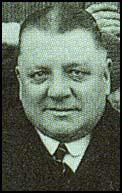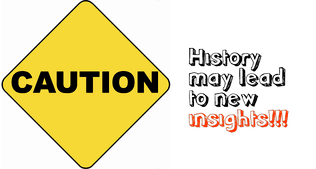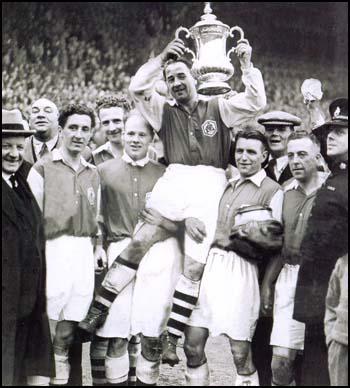 George
Allison was born in Darlington in 1883. After leaving school he
became a local journalist. In 1905 he moved to London. He became
a fan of Woolwich Arsenal and agreed to become the club's
program editor. George
Allison was born in Darlington in 1883. After leaving school he
became a local journalist. In 1905 he moved to London. He became
a fan of Woolwich Arsenal and agreed to become the club's
program editor.
Allison was recruited by the BBC as a radio journalist. In
January 1927 the BBC broadcast its first commentary on a
professional football match. Later that year the BBC broadcast
the FA Cup Final. Allison became the BBC's main football
commentator and by 1931 the BBC was broadcasting over 100 games
per season. At this time only about 30% of households owned
radios.
To help the listener understand what was going on, a diagram was
published in the Radio Times which showed a football pitch
divided into numbered squares. During the game Allison's
assistant would call out the number of the square in which the
ball resided.
The Great Depression resulted in a fall in attendances at
football matches. Some club chairman partly blamed radio
coverage for this situation and in June 1931 the Football League
banned all broadcasts of its fixtures. This ban was to continue
until after the Second World War.
The Football Association did not share these negative views of
radio and during the 1930s every FA Cup Final was broadcast by
the BBC.
Allison continued to work for Arsenal and after serving as club
secretary he was appointed as the club's managing director. At
the time, Herbert Chapman, was manager of the club.
In the 1925-26 season Arsenal finished in second-place to
Chapman's old club, Huddersfield Town. Top scorer was Jimmy
Brain who established a new club record with 33 goals. Charlie
Buchan scored 21 goals that season which brought the amount paid
by Arsenal to Sunderland to £4,100.
Henry Norris refused to allow Herbert Chapman to spend much
money to strengthen his team and in the 1926-27 season Arsenal
finished in 11th position.
Herbert Chapman gradually adapted the "WM" formation that had
originally been suggested by Charlie Buchan. Chapman used his
full-backs to mark the wingers (that job had previously been
done by the wing-halves). He also developed what became known as
the counter-attacking game. This relied on the passing ability
of Alex James and goal scoring forwards like David Jack, Jimmy
Brain, Joe Hume, Cliff Bastin, and Jack Lambert. Chapman also
built up a good defense that included players such as Bob John,
Eddie Hapgood, Herbert Roberts, Alf Baker, Tom Parker and George
Male.
Success was not immediate and Arsenal finished in 14th place in
the 1929-30 season. They did much better in the FA Cup. Arsenal
beat Birmingham City (1-0), Middlesbrough (2-0), West Ham United
(3-0) and Hull City (1-0) to reach the final against Chapman's
old club, Huddersfield Town. Arsenal won the game 2-0 with goals
from Alex James and Jack Lambert.
The following season Arsenal won their first ever First Division
Championship with a record 66 points. The Gunners only lost four
games that season. Jack Lambert was top-scorer with 38 goals.
Other important players in the team included Frank Moss, Alex
James, David Jack, Cliff Bastin, Joe Hume, Eddie Hapgood, Bob
John, Tom Parker, Herbert Roberts, Alf Baker and George Male.
Alex James was injured for a large part of the 1931-32 season
and this was a major factor in Arsenal losing the title by two
points to Everton. James was back in the 1932-33 season. George
Allison said of James: "No one like him ever kicked a ball. He
had a most uncanny and wonderful control, but because this was
allied to a split-second thinking apparatus, he simply left the
opposition looking on his departing figure with amazement."
Arsenal won the First Division by four points that season. Cliff
Bastin, the team's left-winger, was top scorer with 33 goals.
Joe Hume, the right-winger, scored 20 goals. This illustrates
the effectiveness of Chapman's counter-attacking strategy.
On 1st January 1934 Herbert Chapman went to watch Notts County
play Bury as he was interested on one of their young players.
The following day he attended the game between Sheffield
Wednesday and Birmingham City. Wednesday were the visitors at
Highbury on the following Saturday and Chapman considered them
to be Arsenal's main rivals for the league championship. He
developed a cold but insisted on watching Arsenal's third team
play on the Wednesday. The following day he was forced to take
to his bed and died of pneumonia on Saturday morning.
George Allison was appointed as the new manager. Allison was a
radio journalist who was also the club's managing director.
However, he had no experience of football management. At the
time of Chapman's death Arsenal were top of the table and Tom
Whittaker and Joe Shaw were allowed to run the team until the
end of the season.
Bob Wall claimed that "Allison was a complete contrast to
Chapman... He never claimed to possess a deep theoretical
knowledge of the game but he listened closely to what people
like Tom Whittaker and Alex James had to say. Like Chapman
before him, Allison always insisted that, no matter how good a
prospective signing might be, he would secure him only if his
character was beyond reproach."
Sunderland was their main challengers to Arsenal in the 1933-34
season thanks to a forward line that included Raich Carter,
Patsy Gallacher, Bob Gurney and Jimmy Connor. In March 1934
Sunderland went a point ahead. However, the Gunners had games in
hand and they clinched the league title with a 2-0 victory over
Everton. One of the goals was scored by goalkeeper Frank Moss
who suffered a dislocated shoulder and was forced to play on the
left-wing for the remainder of the game.
In March 1934, George Allison paid £6,500 for Ted Drake who had
been scoring a lot of goals for Southampton in the Second
Division. Herbert Chapman had tried to buy him the previous year
but his offer had been refused. Allison also purchased Jack
Cranston for £5,250 in May 1934.
Another important signing was Wilf Copping. In June 1934, George
Allison, paid £8,000 for the England international. As one
historian has pointed out: "Wilf Copping was the original hard
man of English football... with his boxer's nose and build, his
unshaven appearance on match days and the bone shaking charges
and tackles which were his trademark. Copping, at left half, was
liable to unnerve the opposition with just one fixed stare from
his craggy face."
Ted Drake scored 42 goals in 41 games in the 1934-35 season.
This included three hat-tricks against Liverpool, Tottenham
Hotspur and Leicester City and four, four-goal hauls, against
Birmingham City, Chelsea, Wolves and Middlesbrough. These goals
helped Arsenal to win the league championship. Jeff Harris, the
author of Arsenal Who's Who argues that "Drake's main attributes
were his powerful dashing runs, his great strength combined with
terrific speed and a powerful shot. Ted Drake was also brilliant
in the air but above all, so unbelievably fearless."
Ted Drake had a particularly good game against Aston Villa on
14th December, 1935. He was suffering from a knee injury but
George Allison decided to risk him. By half-time he had scored a
hat-trick. Drake scored three more in the first 15 minutes of
the second-half. Drake then hit the bar and when he told the
referee it had crossed the line, he replied: "Don't be greedy,
isn't six enough". In the last minute he converted a cross from
Cliff Bastin. Seven goals in an away game was an amazing
achievement.
However, a serious knee injury, that needed a cartilage
operation, put Ted Drake out of action for ten weeks. Arsenal
missed his goals and only finished in 6th place behind
Sunderland. Arsenal did much better in the FA Cup that season.
Arsenal beat Liverpool (2-0), Newcastle United (3-0), Barnsley
(4-1) and Grimsby Town (1-0) to reach the final against
Sheffield United. Drake, who was not fully fit, scored the only
goal of the game. |
|
|
Some of Arsenal's key players such as Alex James, Cliff Bastin, Joe
Hume, Bob John and Herbert Roberts were past their best. Ted Drake and
Ray Bowden continued to suffer from injuries, whereas Frank Moss was
forced to retire from the game. Given these problems Arsenal did well to
finish in 3rd place in the 1936-37 season.
Before the start of the 1937-38 season Herbert Roberts, Bob John and
Alex James retired from football. Joe Hume was out with a long-term back
injury and Ray Bowden was sold to Newcastle United. However, a new group
of younger players such as Bernard Joy, Alf Kirchen and Leslie Compton,
became regulars in the side. George Hunt was also bought from Tottenham
Hotspur to provide cover for Ted Drake who was still suffering from a
knee injury. Cliff Bastin and George Male were now the only survivors of
the team managed by Herbert Chapman.
Wolves were expected to be Arsenal's main rivals in the 1937-38 season.
However, it was Brentford who led the table in February. They also beat
Arsenal on 18th April, a game in which Ted Drake broke his wrist and
suffered a bad head wound. However, it was the only two points they won
during a eight game period and gradually dropped out of contention.
On the last day of the season Wolves were away to Sunderland. If Wolves
won the game they would be champions, but they drew 1-1. Arsenal beat
Bolton Wanderers at Highbury and won their fifth title in eight years.
As a result of his many injuries, Ted Drake only played in 28 games but
he still ended up the club's top scorer with 17 goals.
George Allison was aware that Arsenal had never been able to replace the
retired Alex James and therefore lacked creativity in midfield. In
August 1938 Allison decided to buy Bryn Jones of Wolves for the world
record fee of £14,000 (£6.9 million in today's money). Politicians were
outraged by the money spent on Jones and the subject was debated in the
House of Commons.
Bryn Jones scored on his debut against Portsmouth. He also found the net
in two of his next three games. However, the goals dried up and he was
only to get one more before the end of the season. After Arsenal were
beaten at home 2-1 by Derby County, the match reporter from the Derby
Evening Telegraph wrote: "Arsenal have a big problem. Spending £14,000
on Bryn Jones has not brought the needed thrust into the attack. The
little Welsh inside-left is clearly suffering from too much publicity,
and is obviously worried. He is a nippy and quite useful inside-left,
but his limitations are marked."
In his first season Bryn Jones scored four goals in 30 league
appearances. That year Arsenal finished 5th in the league, eight points
behind Wolves who appeared to be doing very well without Jones. As Jeff
Harris pointed out in Arsenal Who's Who (1995): "To lay blame on Bryn
Jones for the club's lack of success that season was unfair, for in a
nutshell, the quiet, modest, self evasive, lonely figure could not cope
with the intense pressure of the media spotlight even though his good
positional awareness and splendid ball control were there for everyone
to behold."
George Allison claimed that Bryn Jones needed more time to settle into
the team. Cliff Bastin disagreed and in his autobiography he commented:
"I thought at the time this was a bad transfer, and subsequent events
did nothing to alter my views. I had played against Bryn in club and
international matches and had ample opportunity to size him up."
Bernard Joy later wrote: "Do we write Bryn Jones down as a gamble that
failed, or would he have been a success eventually? The outbreak of war
in September 1939 prevented us from ever finding the complete answer.
There were signs before then that, as James had done, he was weathering
the bad patch which always seems to follow a change of style from an
attacking to a foraging inside-forward... My own view, however, is that
Jones's modesty was the barrier to achieving the key role Arsenal had
intended for him. He could not regard the spotlight as a challenge to
produce his best; all the time it irked him, making him self-conscious
and uneasy.”
On the outbreak of the Second World War the Football League was
suspended. By the time the competition restarted after the conflict,
Nearly all Arsenal's 1930s stars had retired from the game. Allison
retired at the end of the 1946-47 season after Arsenal finished in a
disappointing 13th position.
George Allison died on 13th March, 1957.
|



